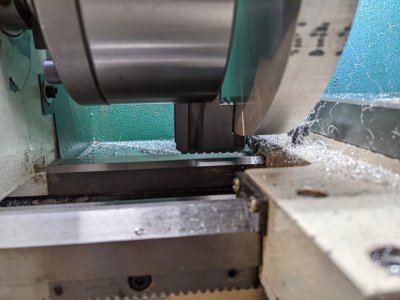- Joined
- Dec 18, 2019
- Messages
- 7,430
I have a 6" four jaw chuck for my G0752/G0602. Just bought an 8" diameter disc 0.8" thick of 6061 to make a fixture plate for a recently purchased rotary table. How many threads of engagement should I have in each jaw? The jaws look far enough out that I'm wondering how safe it is. Obviously I will check for clearance, but my question is really how many threads are needed. The 4 jaw screws have two sections of thread, an inner thread and outer. The jaw does not engage the inner thread at all.
My plans on the lathe are to face the plate (it is saw cut, but not bad) both sides and to bore a 30mm hole in the center. Once I have done that (and some chamfering) then I will do the rest of the machining on the mill.
Don't want to do anything ridiculously unsafe, yet really have no need for an 8" chuck (I think). What is reasonable practice, and what would you do?
My plans on the lathe are to face the plate (it is saw cut, but not bad) both sides and to bore a 30mm hole in the center. Once I have done that (and some chamfering) then I will do the rest of the machining on the mill.
Don't want to do anything ridiculously unsafe, yet really have no need for an 8" chuck (I think). What is reasonable practice, and what would you do?

